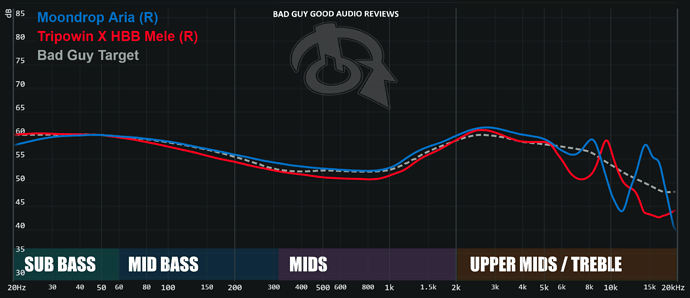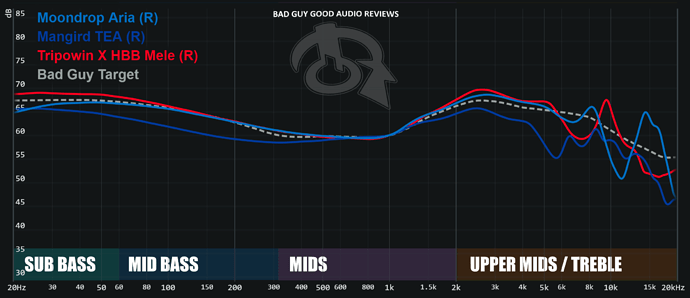No more links here, don’t worry
Same as me, complete different sets.
Sure, let me help you.
FR is a like a scale. You put somewhere, it gets prenounced, so you get less from somewhere else.
On that specific graph, as you can see, mids are pretty close, because the graph his set to be normalized at 1k Hz. Mids will look the same, but since Mele has more bass, mids will be slightly more recessed. You pull something up, it gets more in you face, other stuff go behind.
Let me paste this here to help you understand. I’ve normalized it @ 50hz:
When you put them at the same output level @ 50hz, you get slight less mids and even slighter less treble, but it’s there. You also get less sub-bass. It comes out as preference on the tuning. Aria will probably sound slighly more detailed but with less slam. Libraries and preferences will set this up for each one.
FR isn’t hard to read, but only tell half a story. You can judge timbre, technicalities, coherency, etc. A perfect example is my favourite IEM, Mangird tea. Most people look at this graph and just roll over. They will say no bass, no treble, bla bla bla:
Strong point of mangird Tea is mids. Just look what happens when I normalized it @ 200hz:
If you have more questions, please let me know, I’ll help you.
Are legacy 4’s considered fast when it comes to bass? Or are l2’s just way better on that front? ( I know the quantity of midbass is not that high but was wondering)
Hey there, I find your way comparing different IEMs on the graph interesting. May I ask does what does each @Hz mean? Like why do you set @50Hz for Aria and Mele but different for the other comparison which included Tea?
The Hz are frequencies. The further to the right, the higher notes you get.
Nymz normalized to certain frequency values just because they made the lines show what he wanted to show. The normalizing values aren’t that important, since everything in these graph is relative.
By convention, many people normalize at 1kHz, but you can normalize at another frequency if it helps you visualize/show some differences.
So it doesn’t necessarily mean normalising @200Hz shows the difference in the Mids?
The Legacy 4 has an updated DD past the Legacy 3 and Theiaudio’s first tribrids. The Oracle and Excalibur adopted the Legacy 4’s DD design. The Legacy 2’s DD is beryllium coated and sounds substantially different than all the other Thieaudio DD designs.
So on the left hand side of the graph is the decibels (loudness). So normalizing is having the loudness at a certain frequency be the same. Where you normalize gives a way to compare the relative differences in how loud each frequency is from a known point.
So if you adjusted the volume of 2 IEMs so a 1000Hz frequency was the same the relative frequencies around them would be at a different level then if you adjusted them to be the same at 200Hz. Due to different sound signatures.
I think you missed the point. When you elevate something, you’ll hear more of that frequencies and less on the rest. Think of the graph as an Equalizor. Up and down is decibels (volume) and left and right are frequencies. You can see in the graph the labels Sub-bass/mid-bass etc.
I normalized at 200hz just to prove a point. at the same volume matched at 200hz, you’ll hear more mids on Tea > Aria > Mele.
Like Tk said, it’s prety standard to normalize at 1K, before the pinna gain. I just made it to prove a point. You can look it as you need it to. I usually focus on how mids and mid bass are displayed on a graph because I know what my prefered target is.
Ooooh I see I see… Thanks guys another new knowledge 

Np. If you or any other person have doubts about graphs, I’ll try to help the best as I can. Just drop me a PM or something
If you crave for more knowledge on reading graphs, here’s a slightly overwhelming but packed with good knowledge piece of 101 by Crinacle:
This is a very easy song for Mele. And first 30 seconds of the song’s bass is better with Mele. Blon 03’s is not bad but felt that Mele’s bass is another step forward. Btw, listened to Teas as well, conclusion is that it’s more fun and enjoyable to listen to such songs with Mele.
Aight thanks 
I’m disappointed: today is not he day i’ll hget Mele.
But soon… Soon…
My sister’s Yun Express tracking shows delivered, no signature. Separate from the recent updates that said it was ready/out for delivery. She doesn’t have it though.
They live in a country house with no immediate neighbors, so not a porch/door mistake.
I’ll see what happens tomorrow. Maybe they like to say it’s delivered early. If it’s not there tomorrow I’m contacting Linsoul for her.
So of the people that ordered around 5 am- linsoul
Time on the 20th did anyone get one yet?
I think some did, some didn’t. Not sure how it has been handled but Linsoul only has resumed shipping today, not just for Mele…
I can feel the riots incomming 
I have had the Mele for a week . I think they are wonderful. They are not the most technical and I know they can be surpassed in that by other iems. They have a wonderful musicality. They are non fatiguing and so comfortable to wear. This invites long listening sessions.
HBB what great tuning, a masterpiece in my opinion. I will buy other iems that surpass the Mele in areas but they will have a place in my collection. My library is wider than classic rock but I feel they do justice to all of it. The reason we all got into this was love for music.This set definitely is all about the music. They belong in many peoples library. Thanks HBB for this set.


